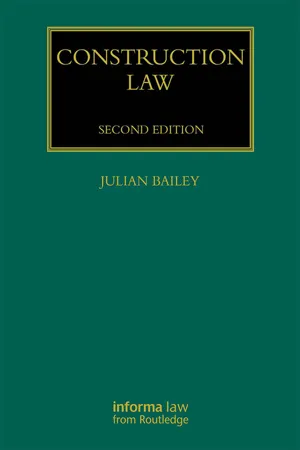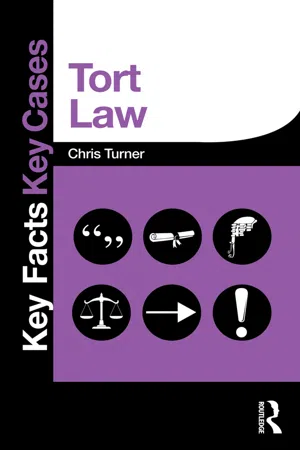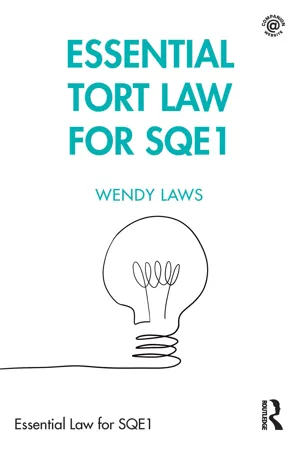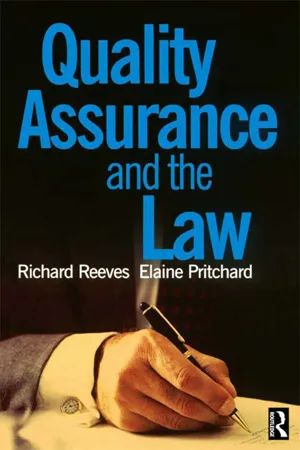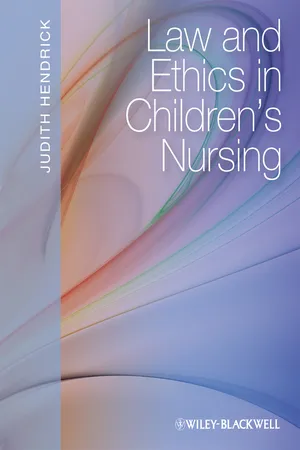Law
Elements of Negligence
The elements of negligence are the key components that must be proven in a negligence case. These elements typically include duty of care, breach of duty, causation, and damages. Duty of care refers to the legal obligation to act reasonably to avoid causing harm to others, while breach of duty occurs when this obligation is not met. Causation establishes the link between the breach of duty and the resulting harm, and damages refer to the actual harm suffered.
Written by Perlego with AI-assistance
Related key terms
1 of 5
8 Key excerpts on "Elements of Negligence"
- eBook - ePub
- Julian Bailey(Author)
- 2016(Publication Date)
- Informa Law from Routledge(Publisher)
Chapter 10 Negligence- What is negligence?
- Elements of Negligence
- Element 1: A duty of care
- (i) The duty of care concept
- (ii) Type of foreseeable harm, injury or loss
- (iii) The likelihood of the harm, loss or damage eventuating
- (iv) Assumption of responsibility and vulnerability
- (v) "Fair, just and reasonable"
- (vi) Disclaimer
- (vii) Insurance
- (viii) Statutory imposition of duty of care / statutory duties
- Element 2: Breach of duty
- (i) Generally
- (ii) Professional negligence
- (iii) Vicarious liability and non-delegable duties
- Element 3: Causation of harm, loss or damage
- (i) Introduction
- (ii) Reliance and causation
- (iii) Intervening acts and events
- (iv) Australian civil liability legislation
- Application to the construction and engineering industries
- Contractor
- (i) Harm or injury to person/damage to "other property"
- (ii) Pure economic loss
- Subcontractor
- (i) Duty to main contractor
- (ii) Duty to third parties
- Contract administrator
- Owner
- (i) Duty to construction operatives
- (ii) Purchaser or occupier
- (iii) Government of Singapore
- Architect
- (i) Duty to client
- (ii) Duty to third parties
- eBook - ePub
- Graham Stephenson(Author)
- 2012(Publication Date)
- Routledge-Cavendish(Publisher)
In addition, as society moves from a largely manufacturing based economy to a services dominated one, there is a consequential increase in problems arising from the provision of poor or inadequate services. The action based on the tort of negligence has been asked to deal with these types of issues more and more over recent years. It has so far had to bear the brunt of claims for accident compensation as was outlined in Chapter 1 and perhaps it is not so surprising that it is groaning under the pressure. 4 THE Elements of Negligence In this chapter, we are concerned with negligence as an independent tort, rather than negligence relating to the way or manner in which other legal duties may be broken, for example, a negligent breach of contract or a negligent trespass to goods. In these instances, negligence is a word being used to describe the conduct of the defendant where it might be less confusing to use the word ‘careless’. The tort of negligence involves more than just careless behaviour, having developed a conceptual apparatus all of its own to deal with problems of varying kinds. It is often said that negligence comprises three elements: duty, breach and damage. The damage aspect is sometimes broken down into the components of causation and remoteness. It can safely be said that all these elements are interrelated and fused together at times and confusion is often the inevitable result as far as the student is concerned. Some of the confusion is, however, generated by the judiciary, a situation which is avoidable. 5 Judges are often found talking about issues of breach of duty or causation instead of duty and vice versa - eBook - ePub
- Chris Turner(Author)
- 2013(Publication Date)
- Taylor & Francis(Publisher)
2 Negligence: basic elements2.1 Duty of care2.1.1 Negligence – origins and character1 The modern starting point is Lord Atkin’s judgment inDonoghue v Stevenson (1932), which established negligence as a separate tort – though its origins were in actions on the case.2 A new approach was needed, as no other action was available.3 The judgment contained five key elements.Negligence is a separate tort.Lack of privity of contract is irrelevant to mounting an action.Negligence is proved as a result of satisfying a three-part test:i) there must be a duty of care owed by defendant to claimant;ii) the duty is breached by the defendant falling below the appropriate standard of care;iii) the defendant causes damage to the claimant that is not too remote a consequence of the breach. - eBook - ePub
- Wendy Laws(Author)
- 2021(Publication Date)
- Taylor & Francis(Publisher)
PART 3NegligencePassage contains an image
4Negligence: duty of care
DOI: 10.4324/9781003133698-8
This chapter begins with an overview of the tort of negligence, setting out the elements a claimant must establish for a successful claim: duty of care; breach of duty; and causation of damage.4.1 Chapter overviewIt then explains the principles for the first of those elements: duty of care. It explains that there is a range of established duty situations, contrasting this with novel duty situations in which a duty of care has not been previously established. It then outlines the factors to be considered by the court when deciding whether or not a duty of care is owed in a novel duty situation.
A claim in the tort of negligence requires the claimant to establish that:4.2 The tort of negligence – overview- The defendant owed the claimant a duty of care.
- The defendant breached that duty by falling below a reasonable standard of care.
- The defendant’s breach of duty caused the harm the claimant suffered, and the harm was not too remote a consequence of the breach.
The defendant may seek to defend the claim either by showing that one of these elements has not been made out or by establishing a specific defence to the claim. Each of these aspects is described in more detail in the following chapters.In this chapter we outline the first of those elements, duty of care. The claimant must show that the defendant owed them a duty of care. If it is found that no duty of care was owed, then the claim will fail. In other words, a defendant may have acted carelessly and caused damage to the claimant; but if no duty of care is owed, there will not be a successful claim.The existence of a duty of care depends on the relationship between the claimant and the defendant.1 - eBook - PDF
- Helen Caulfield(Author)
- 2011(Publication Date)
- Wiley-Blackwell(Publisher)
Where the health outcome is different from what had been expected, this does not mean that a negligence action will be successful. The law will not deal with genuine accidents in the context of a negligence claim. The key issue in a case of negli-gence is that another person can be shown to be at fault for the outcome. Where there is no one to blame for the outcome, there can be no negligence. Summary • There is no Act of Parliament that defines negligence. • A set of principles have been decided by case law that must succeed for a claim in negligence to succeed. Concepts: Negligence 113 • Each principle has to be proved before a claim in negligence will succeed. • Negligence has been criticised for the time, cost and remedies that are involved. • Genuine accidents should not be confused with negligence. • The key issue in negligence is that a person or a system is at fault. The first principle: duty of care This first principle of negligence is that a duty of care must be owed by one person to another. This is based on the ideal that a duty to take care is owed by one person to another where there is a connection that can be described as a neighbour principle. If this duty does not exist, there cannot be a claim in negligence. This principle was based on the case of Donoghue v. Stephenson in 1932, set out in more detail in Case Study 8.1. In health care the duty of care is usually straightforward and not an issue of contention. A person receiving treatment from a doctor or nurse will be owed a duty of care by that professional. If the person has treatment using equipment which is faulty, the manufacturer of that equipment will owe a duty of care to the patient. How far the duty of care can be extended is an issue that has been tested in the courts. - eBook - ePub
- Elaine Pritchard, Richard Reeves(Authors)
- 2013(Publication Date)
- Routledge(Publisher)
However, it should be noted that claims of negligence are the most commonly arising of all the torts for it covers a host of illnesses which may arise through working conditions, accidental injury situations or harm which may arise as a result of medical treatment. All of these areas could well be encompassed within a company’s quality or combined quality/safety procedures. In addition to which, negligence also affords a degree of consumer protection, which is an area with which all quality assurance management systems should be concerned. An additional point to be borne in mind is that, it is not only negligent acts which need to be avoided. People involved with giving professional advice, such as lawyers, accountants and surveyors, need also to be aware of the potential liability they face for any negligent statements that they may make, or advice they may give. As with all civil law, the burden of proof is on the plaintiff. The plaintiff must prove his case on the balance of probabilities. In cases of negligence the plaintiff has to be able to prove the other party was negligent. This is known as fault liability. To be successful in a negligence action, the plaintiff must show the following. 1 that the defendant owed the plaintiff a duty of care; 2 there was a breach of that duty of care; and 3 loss or injury arose directly as a result of that breach of duty of care. The concept of a duty of care, was derived from case law rather, than from an Act of Parliament. Similarly exactly what constitutes a breach of that duty and whether or not injury arose directly because of the breach is also governed by case law. As a result the following pages contain an explanation of these terms together with the relevant cases from which they were derived, refined or put to the test. Duty of Care Since the case of Donoghue v. Stevenson (1932) a manufacturer can be sued in the tort of negligence for harm caused by a defect in their product - eBook - ePub
- Judith Hendrick(Author)
- 2011(Publication Date)
- Wiley-Blackwell(Publisher)
One of the ways the government hoped to deal with the so-called compensation culture was to introduce a statutory approach to the standard of care (Harpwood, 2007, p. 205). The Act did not create new law but aimed to remind judges that when they assess the standard of care they should not set it too high – otherwise they might deter socially useful activities. In a clinical context, the intention was to make sure that, for example, Good Samaritan health professionals would not be put off giving assistance for fear of being sued or because of a risk-obsessed culture (Tingle, 2007, p. 71).3.10 Causation 3.10.1 Factual causationThe third element in a negligence claim is the causation one. There are two types of causation: factual causation and legal causation. Factual causation requires the claimant to show a historical connection between the defendant’s negligence and her injuries (Lunney and Oliphant, 2008, p. 211). In theory, proving that the defendant’s breach of duty caused (or materially contributed to) the claimant’s injuries should be relatively easy to establish since the standard of proof is the civil one, namely, the balance of probabilities, i.e. that it was more likely than not or at least a 51% chance that the negligent conduct caused the injury (Lewis, 2006, p. 254). Yet case law on causation has consistently shown how this element is, in practice, the most difficult hurdle for claimants to overcome.Lewis (2006, pp. 321–342) explains why:- The aetiology of medical conditions is notoriously complex and obscure;
- The position may be complicated by the presence of an underlying illness or pre-existing vulnerabilities;
- The problem of ascertaining exactly what was done in the course of treatment;
- The difficulty of securing expert evidence;
- The ‘sad fact of life’ that, as is not uncommon, vital records go ‘missing’.
It is perhaps not surprising that the law reports are full of cases where the defendant has succeeded on some causation argument or other (Lewis, 2006, p. 229). That said, in some cases the so-called ‘but for’ test works to favour the claimant.The ‘but for’ testThe ‘but for’ test is the usual starting point for establishing negligence. According to this test, claimants simply need to show that ‘but for’ the defendant’s conduct they would not have been injured. For example, in Edler v Greenwich and Deptford Hospital Management Committee (1953), The Times - eBook - ePub
- Claudia Carr(Author)
- 2015(Publication Date)
- Routledge(Publisher)
Making Amends even noted that in some smaller-value claims, the costs of the case outweighed the compensation awarded to the aggrieved patient. Although very few cases end up in court because they are settled before trial, the lack of a public airing of the issues means that although the patient is compensated, lessons are less likely to be learned.The consultation paper Making Amends led to the NHS Redress Act 2006, which intended to address some of the criticisms regarding the handling of lower-value clinical negligence claims. The Act aims to investigate the patient’s claim, apologise to the patient where appropriate and take steps to avoid a re-occurrence and, finally, to compensate the patient for the injuries caused. The NHS Redress Act has yet to come into force.In some cases, where the patient has been treated privately, there will be a contractual relationship between the medical professional and the patient and the patient could sue in contractual law for breach of contract. On very rare occasions, negligence could be considered to be so ‘gross’ that the defendant may be found to be criminally liable for gross negligence manslaughter (see R v Adomako [1995] 1 AC 171). However, by far the majority of cases are carried out under the tort of negligence.NEGLIGENCE In order to establish negligence three elements must be proved by the claimant. They are a duty of care; a breach of duty of care; and causation. Figure 5.1The injured patient (the claimant) must prove that the defendant owed her a duty of care, which was breached by the defendant by his failure to use reasonable care and skill. The defendant’s breach that caused the claimant’s injury must not be too remote.THE DUTY OF CAREIf you have studied tort law you will recall the principle set down by Lord Atkin in the case of Donoghue v Stevenson [1932] AC 562, where it was held that a duty of care is established where the injury caused by the other is reasonably foreseeable. The reality is that there is little difficulty in establishing a duty of care between doctor and patient in much the same way as there is a duty between teacher and pupil and train driver and passenger. The principle is demonstrated in the very old case of Pippin v Sheppard
Index pages curate the most relevant extracts from our library of academic textbooks. They’ve been created using an in-house natural language model (NLM), each adding context and meaning to key research topics.
